Looking For The Earliest Life On Earth

Elso S. Barghoorn, an American paleontologist, revealed the discovery of microscopic fossils in October 1977. This discovery, which was dated at 3.4 billion years old, advanced the age of the earliest known signs of life. Come hear more from A.S.Ganesh about Barghoorn and his quest to find the earliest life form.
Do you understand what Precambrian means? It is a unit of geologic time that represents the very beginning of Earth’s history. It is so named because it lasts from the time the earth first started to form, some 4.6 billion years ago, to the Cambrian Period, which is 541 million years ago. The Cambrian is named from Wales’ Latinized name for the period, Cambria. Wales is where the majority of the rocks from this period were first examined.
Precambrian life forms were not discovered in fossil form until the 1950s. The Precambrian record was, however, pushed back in time over the ensuing decades by a series of discoveries. Elso Sterrenberg Barghoorn, an American paleontologist, was one of those in charge of making it happen.
Secrets of the Figtree
In 1977, Barghoorn and Knoll (now the Fisher Professor of Natural History) revealed their discovery of microscopic, single-cell organisms that were 3.4 billion years old. Very thin slices of chert, a hard, fine-grained sedimentary rock, from the Figtree site in the Swaziland System were studied under a microscope, where the cells were discovered. The fact that the cells were identified in varied phases of cell division made this discovery even more amazing.
Although Barghoorn and Knoll published their findings in the October 28 issue of Science, word of their discovery had already begun to spread. The Washington Post published a piece headlined “Paleontology Rebirth” on October 3 that utilized this discovery as a benchmark, and on October 24, days after the Science issue hit newsstands, The New York Times published an item titled “Earliest Life Forms Are Found in Rocks.”
These fossils’ precise ages were ascertained by radiometric dating, which was at the time utilized to calculate the age of moon rocks brought back by the Apollo missions. In relation to that, Barghoorn worked as a consultant for NASA, assisting in the creation of strategies for the solar system’s biological exploration and doing microscopic analyses on lunar materials.
Barghoorn passed away in his sleep at the age of 68 in January 1984. He will be best known for adding nearly 3 billion years to our understanding of the fossil record of life, but equally significant was the way he inspired and instilled principles in his students, who he informed and listened to without making requests or demands on.
News Mania Desk






